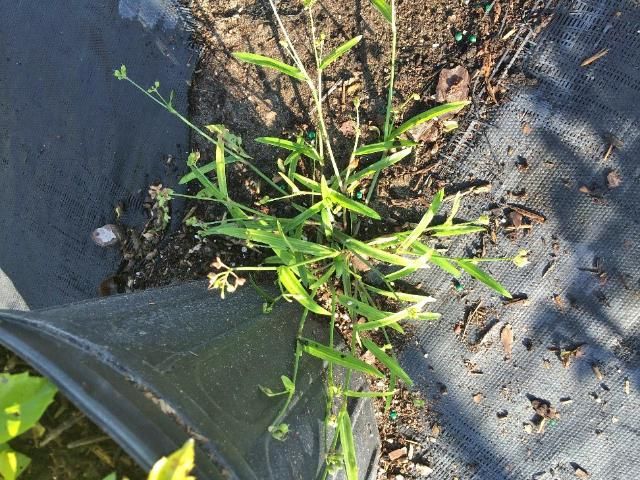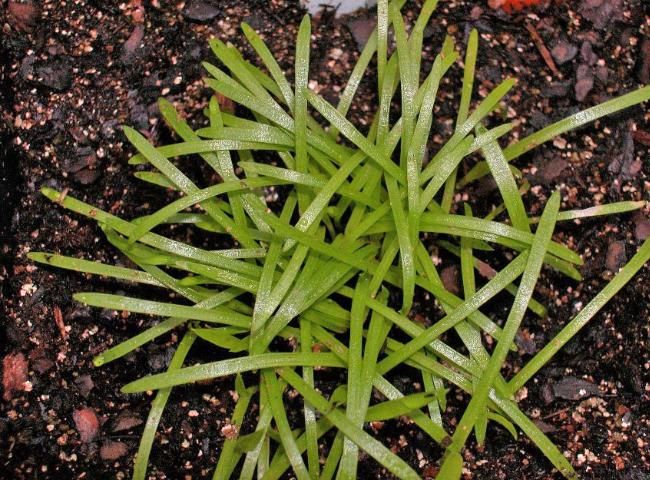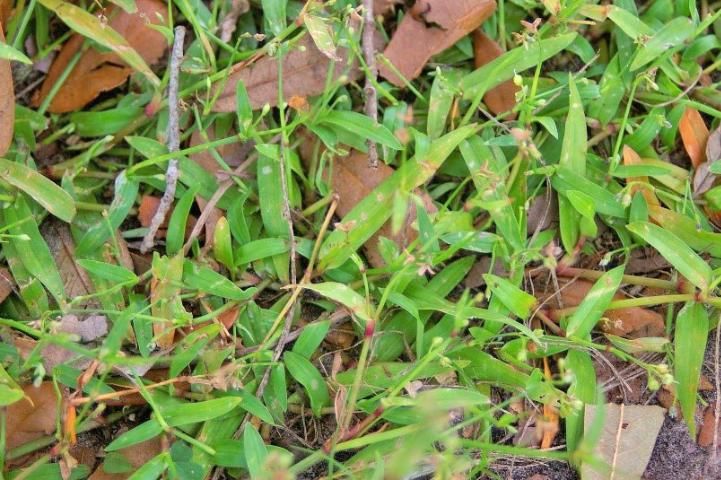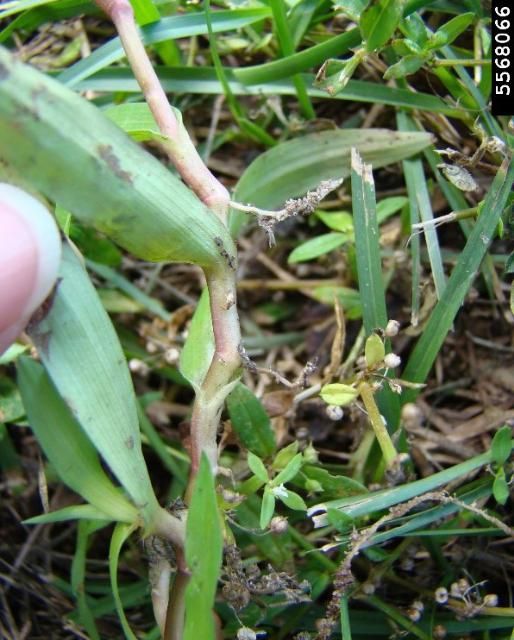Introduction
Doveweed is a common grass-like warm-season annual weed in Florida landscapes, container nurseries, and other agricultural production systems. This article is written for green industry professionals and others to aid in the identification and management of doveweed in and around ornamental plants. Information on doveweed management in warm-season turfgrass species can be found at https://edis.ifas.ufl.edu/pdffiles/AG/AG39500.pdf.
Species Description
Class
Monocot
Family
Commelinaceae—Spiderwort family
Other Common Names
Doveweed, nakedstem dewflower
Life Span
Warm-season annual
Habitat
Doveweed is a well-documented problem in landscape beds, turfgrass, and many agricultural crops. In container nurseries, doveweed grows in the potting soil of container-grown ornamentals, in drainage holes, or in walkways, aisles, ditches, and other areas that stay wet, such as low-lying areas or poorly drained soils.
Distribution
Doveweed is native to southern Asia and tropical Pacific regions but has been naturalized in tropical and subtropical regions of North America (Wagner et al. 1999). Doveweed has also naturalized in many areas of Africa, Oceania, Central and South America, and the West Indies. In the United States, doveweed can be found from North Carolina west to Texas and south to Florida (USDA-NRCS 2019). Occurrence of doveweed has been documented in 39 of 67 Florida counties (USDA-NRCS 2019; Wunderlin et al. 2019).
Growth Habit
Doveweed is usually a low-growing, creeping annual with leafy or succulent branches. Stems may be either erect (upright) or semi-erect up to 12 inches tall, but doveweed usually does not reach this height (Figure 1). Doveweed forms dense mats by rooting along its nodes when the nodes are in contact with the soil.

Credit: Annette Chandler, UF/IFAS
Seedling
Germination begins during the onset of warm and wet weather, typically around April or May in Florida, and continues throughout the summer. The leaves of young plants grow in a circular arrangement (rosette). The creeping stems are succulent, root along the nodes, and are grass-like (Figure 2).

Credit: Annette Chandler, UF/IFAS
Shoots
The stems of the plant may not be visible, especially when growing in a dense mat. However, the stems are succulent, round, and smooth, and they root extensively along the nodes. The stems may be purplish to reddish in color (Figure 3). The leaves have parallel venation and are 2 to 5 inches long, 0.25 to 0.5 inches wide, narrow, pointed, spirally arranged, and clasp the stem (Figure 4). When young, doveweed is often misidentified as a grass. Leaf sheaths have soft hairs on the upper margins. Doveweed shoots often have a shiny appearance compared to other weed species.

Credit: Annette Chandler, UF/IFAS

Credit: Annette Chandler, UF/IFAS
Roots
Doveweed has a fibrous root system comprised of thin roots that are white to brown in color. The roots emerge from the nodes and may be hairy (Figure 5).

Credit: Rebekah D. Wallace, University of Georgia, Bugwood.org
Inflorescence
The flowers are stalked and form in small clusters from midsummer throughout the fall. They are short-lived, in terminal or axillary long-stalked inflorescences (Figure 6). Flowers are blue or purple in color with 3 sepals and 3 petals that are 0.2 to 0.5 inches long. It has three to four sterile stamens (pollen-bearing organ of a flower) with long bearded filaments and bluish-colored anthers.

Credit: Annette Chandler, UF/IFAS
Fruit and Seeds
The fruit is a condensed capsule that is glabrous and tapered at the end. The fruit is spherical or egg-shaped (ovoid-globose) and 0.1 to 0.2 inches wide. Fruit has 3 locules (segments) with one to two seeds in each segment. Seeds are dark brown, smooth to coarse in texture, subtriangular, and covered with tubercles (wart-like pieces). Seeds are mainly dispersed by wind, water, animals grazing, and fecal droppings of animals or during tillage. It reproduces by both seed and by forming roots along the shoots.
Similar Species
Murdannia nudiflora is similar in appearance to the Asiatic dewflower (Murdannia spirata) and can be mistakenly identified as the common dayflower (Commelina diffusa) (CABI 2019). Both of these species typically have much larger inflorescences and wider leaf blades than doveweed. In addition, these species grow much larger, and common dayflower is typically more vigorous (Soerjani et al. 1987). Marsh dayflower (Murdannia keisak) is another similar species but is less common in nurseries. Marsh dayflower is also larger and more vigorous than doveweed (Neal and Derr 2005).
Plant Biology
Seeds usually germinate when soil temperatures reach 65°F to 70°F late in the spring, with peak germination usually occurring when temperatures reach over 80°F (Wilson et al. 2006) during late April and May in Florida as temperatures and rainfall increase. Light is required for germination, and germination may be reduced by over 90% when seeds are covered by 1 inch or more in the soil (Ahmed et al. 2017). When mature, each plant can produce 500 to 2000 seeds, which are immediately viable but may remain dormant until the following year when conditions are ideal for germination. The plant flowers and dies following frost in the fall/winter. Doveweed is categorized as one of the world's worst weeds (Holm et al. 1977) due to its ability to root easily along the nodes and adapt and survive in a wide range of soil types and environments.
Management
Physical and Cultural Control
Doveweed is becoming a more common weed in container nurseries and has been a problematic species in landscapes and other cropping systems in the southeastern United States for many years (Walker et al. 2010). It thrives in wet areas, so correcting drainage issues and irrigating properly can help prevent the spread of doveweed (Leon and Unruh 2015). Mulch applied at depths of 1 to 3 inches can be used in container-grown ornamentals or in landscape beds to prevent or reduce doveweed growth and germination. It is usually easy to hand-pull, but small stem fragments left behind have the ability to regrow. Because doveweed is a low-growing plant, mowing is usually not an effective management approach, but hand-weeding can be effective.
Chemical Control
Preemergence
Doveweed is typically much easier to manage with preemergence herbicides compared to postemergence herbicides (Stamps and Chandler 1999; Walker et al. 2010). In nurseries, granular herbicides, including flumioxazin (Broadstar®), pendimethalin + dimethenamid-P (FreeHand®), or indaziflam (Marengo® G), or spray-applied herbicides, such as dimethenamid-P (Tower®) or S-metolachlor (Pennant Magnum®), can be used for preemergence control of doveweed and can be applied over-the-top of labeled ornamental species to control doveweed in containers. These herbicides can also be used in landscape beds; however, Specticle® G is the trade name for indaziflam labeled for use in landscapes. In bareground areas or in situations where a directed application is needed (applied to avoid contact with the crop), spray-applied herbicides such as SureGuard® (flumioxazin) or Marengo® SC/Specticle® FLO (indaziflam) can be used. Efficacy rankings and labeled uses for other preemergence herbicides are included in Table 1.
Postemergence
Most postemergence herbicides recommended for controlling doveweed are not labeled for use in container nurseries or in landscape planting beds. Nonselective herbicides such as glyphosate (many trade names available) or glufosinate (Finale®) can be used as a directed or spot application (avoiding ornamental plant foliage, stems, etc.) in planting beds, but multiple applications may be required depending upon plant size. Contact herbicides such as diquat (Reward®) or Scythe® (pelargonic acid) can also be used to control small doveweed plants.
References
Ahmed, S., J. L. Opena, and B. S. Chauhan. 2017. "Seed Germination Ecology of Doveweed (Murdannia nudiflora) and Its Implication for Management in Dry-Seeded Rice." Weed Sci. 63:491–501.
CAB International (CABI). 2019. "Murdannia nudiflora (doveweed)." https://www.cabi.org/isc/datasheet/35180
Holm, L. R., D. L. Plucknett, J. V. Panco, and J. P. Herberger. 1977. The World's Worst Weeds: Distribution and Biology. University Press of Hawaii Honolulu, USA.
Leon, R. G., and B. Unruh. 2015. Doveweed (Murdannia nudiflora) Control in Warm-Season Turfgrass Species. SS-AGR-391. Gainesville: University of Florida Institute of Food and Agricultural Sciences. https://edis.ifas.ufl.edu/pdffiles/AG/AG39500.pdf
Neal, J. C., and J. F. Derr. 2005. Weeds of Container Nurseries in the United States. Raleigh, NC: North Carolina Assoc. of Nurserymen, Inc.
Soerjani, M., A. J. G. H. Kostermans, and G. Tjitrosoepomo. 1987. Weeds of Indonesia. Jakarta, Indonesia: Balai Pustaka.
Stamps, R. H., and A. L. Chandler. 1999. "Doveweed, Florida Tasselflower, and Eclipta Control under Heavy Rainfall Conditions Using Granular Preemergence Herbicides." Proceedings of the Southern Nurseryman's Association Research Conference. 50: 435–439.
USDA-NRCS. 2019. "Plants Profile for Murdannia nudiflora (nakedstem dewflower)." https://plants.usda.gov/core/profile?symbol=MUNU
Wagner, W. L., D. R. Herbst, and S. H.Sohmer. 1999. Manual of the Flowering Plants of Hawaii. Volumes 1 and 2. Honolulu, HI: University of Hawaii and Bishop Museum Press.
Walker, L. C., J. C. Neal, and J. F. Derr. 2010. "Preemergence Control of Doveweed (Murdannia nudiflora) in Container-Grown Nursery Crops." J. Environ. Hort. 28: 8–12.
Wilson, D. G., M. G. Burton, J. F. Spears, and A. C. York. 2006. "Doveweed (Murdannia nudiflora) Germination and Emergence as Affected by Temperature and Seed Burial Depth." Weed. Sci. 54: 1000–1003.
Wunderlin, R. P., B. F. Hansen, A. R. Franck, and F. B. Essig. 2019. "Atlas of Florida Plants." http://florida.plantatlas.usf.edu